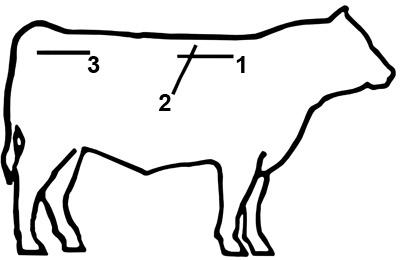Real-time ultrasonography is a non-invasive imaging technique used to evaluate carcass characteristics in live animals. This method employs high-frequency sound waves (typically 2–10 MHz) to visualize subcutaneous tissue layers, similar to pregnancy diagnosis in livestock and humans. A transducer is placed against the animal’s back, emitting sound waves that penetrate tissues and reflect off boundaries between the hide, fat, and muscle layers. The returning echoes generate a cross-sectional image on the ultrasound monitor, allowing for precise measurements of key carcass traits.
Key Measurements and Their Significance
Ultrasound-based carcass assessment provides valuable data for estimating retail yield and meat quality. Common measurements include:
Ribeye Area (REA) – Measured between the 12th and 13th ribs (in square inches), REA indicates muscle mass and lean meat yield.
Backfat Thickness (BF) – Also taken between the 12th and 13th ribs (in inches), BF estimates external fat cover, a critical factor in determining carcass value.
Rump Fat (RF) – Measured along the hip (between the hook and pin bones), RF provides additional insight into fat distribution.
Percent Intramuscular Fat (PIMF) – An objective measure of marbling, which strongly influences meat quality and USDA grading.
Global Applications: Australia, UK, Italy, and France
Australia: Ultrasound is widely used in beef production to enhance feed efficiency and genetic selection. Programs like Meat & Livestock Australia (MLA) promote ultrasound scanning to improve marbling and yield grades.
United Kingdom: British farmers utilize ultrasound for suckler herds and premium beef programs, ensuring compliance with EU carcass classification standards.
Italy: In regions like Piedmont, ultrasound helps optimize Piedmontese cattle for their prized lean, tender meat.
France: The Charolais and Limousin breeds are routinely scanned to maximize muscle development and minimize excess fat.
Advantages of Ultrasound in Livestock Management
Non-invasive & real-time – No harm to the animal, immediate results.
Improves breeding decisions – Identifies high-performance genetics.
Enhances marketability – Predicts USDA/EUROP grading before slaughter.
By integrating ultrasound technology, producers worldwide can optimize carcass quality, improve profitability, and meet consumer demand for premium beef.
Post time: Jun-12-2025




